🧔🏻♂️ The Shaver's Guarantee - Learn More

Merkur Double Edge Razor Travel Case
Product pricing.
5 out of 5 stars
In stock and ready to ship.
Description
Crafted with the utmost care and precision in Germany, this travel razor case is an essential accessory for the modern gentleman. Constructed from genuine top-grade leather, it boasts both durability and sophistication, ensuring that your razor remains protected during your travels. Designed to accommodate most Merkur classic or Futur razors, as well as many other double-edge razors, its black leather exterior features a subtle DOVO/Merkur emblem snap for added style and security.
Ideal for the discerning traveler or anyone seeking quality craftsmanship, this travel razor case combines functionality with elegance. Its compact yet sturdy design makes it the perfect companion for any journey, ensuring that your razor remains safe and secure wherever you go. Whether you're jetting off on a business trip or embarking on a weekend getaway, this meticulously crafted leather case provides peace of mind, allowing you to focus on the journey ahead.
Shipping & Returns
Reviews (2).
- SKU: OP-MER-767
- Brand: Merkur
- Type: Shaving Accessories
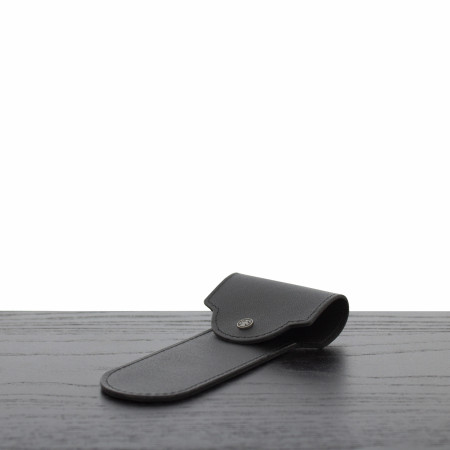
You may also like
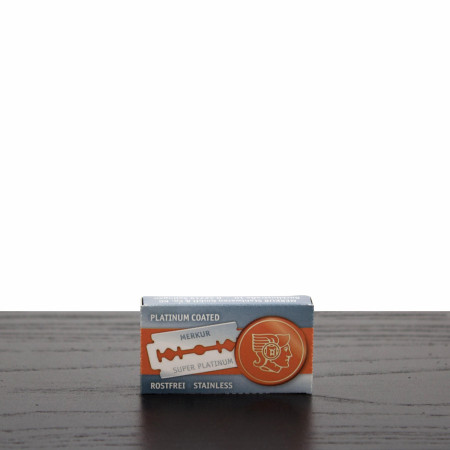
Merkur Double Edge Razor Blades
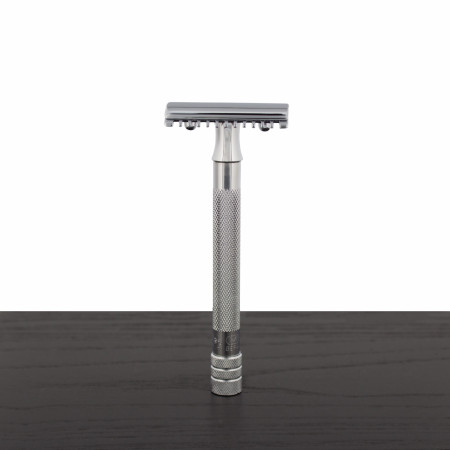
Merkur 25C Long Handle Safety Razor, Open Tooth
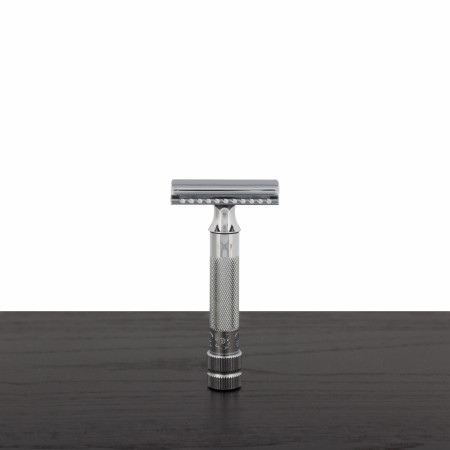
Merkur 34C Heavy Duty Safety Razor
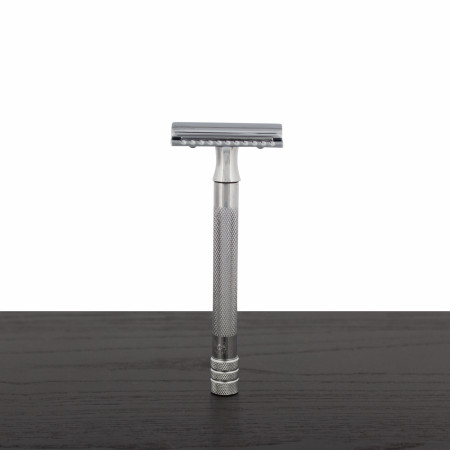
Merkur 23C Long Handle Safety Razor
- FREE SHIPPING on orders $35+
- Order Status
- Reward Points
- Shaving Creams
- Shaving Soaps
- Closed Comb Razors
- Open Comb Razors
- Adjustable Razors
- Butterfly Razors
- Cartridge Razors
- Heads and Handles
- Travel Razors
- Blade Banks
- Badger Bristles
- Synthetic Bristles
- Boar Bristles
- Horse Bristles
- Travel Shaving Brushes
- Traditional
- Japanese kamisori
- With replaceable blades
- Limited editions
- Leather Strops
- Sharpening Stones
- Strop Pastes
- With Double Edge Razors
- With Cartridge Type Razors
- With Straight Razors
- Holiday Sets
- Mugs & Bowls
- Razor & Brush Stands
- Brush Stands
- Razor Stands
- Toiletry Bags
- Razor Pouches
- Razor Head Covers
- Travel Razors & Brushes
- Sensitive Skin
- Thick /Coarse Hair
- Hair Brushes
- Pomades & Gels
- Conditioners
- Face Moisturizers
- Face Washes
- Masks & Scrubs
- Body Washes
- Body Moisturizers
- Body Brushes
- Apothecary Remedies
- Talcum Powders
- Beard Wash & Conditioners
- Beard Balms
- Moustache Waxes
- Brushes, Combs & Scissors
- Manicure Sets
- Nail Brushes
- Hand Creams
- Nose Trimmers
- Eau de Toilettes
- Soap Dishes
- Toothbrush Holders
- Vanity Trays
- Toothbrushes
- Toothpastes
- Bath & Massage Brushes
- Massage Straps & Mitts
- Briefcases & Messenger Bags
- Overnight Bags
- Games & Tools
- Clothes Care
- Leather Care
- Specialty Soaps
- Ink Bottles
- Ink Cartridges
- Fountain Pens
- Ballpoint Pens
- Rollerball Pens
- Cases & Clips
- Pocket Knives
- Small Leathers
- Coin Wallets
- Money Clips
- Slim Wallets
- Zipped Wallets
- New Arrivals
Merkur Travel Double-Edge Safety Razor & Case
In stock, ready to ship
- Description
The Merkur Travel Double-Edge Safety Razor & Case is perfect for the man on the move.
- Folding razor
- Ideal for travel
- Razor features same head as Merkur HD and 38C
- Don't forget the blades! A razor blade sampler is the best way to determine which blade is best suited to individual skin types and razor types.
- Razor: Chrome-plated brass
- Case: Faux leather
- Weight: 2 oz (58 g)
- Length: 3" (7 cm)
COUNTRY OF ORIGIN Germany
We offer FREE SHIPPING for qualified US orders, after all discounts, including vouchers for reward points, and before applicable taxes and shipping charges. Gift card purchases do not count toward the minimum requirement. This free shipping offer may not be combined with any other discounts or promotions. Eligible customers must select the free shipping option during the checkout process to take advantage of the offer.
Orders over $35, qualify for FREE standard shipping . Orders over $100 benefit from FREE 3-Day Shipping . A preferred carrier can be selected at checkout.
Estimated delivery times for free shipping options:
Standard Shipping: 2-8 working days 3-Day Shipping: 1-3 working days
Unfortunately, because of high shipping costs, we cannot offer free shipping for:
- Orders outside U.S.A.
- Orders from Alaska, Hawaii, Associated States, Puerto Rico, US Military Addresses (APO, AFO, etc).
For orders that do not qualify for Free Shipping, we offer discounted shipping rates. To calculate the rate to your destination, click on the "Estimate shipping cost" link on the shopping cart page. Shipping charges vary depending on the location, size, and weight of the package.
For more information about shipping policies click here .
We will offer a full refund or store credit for unused products if returned to us within 365 days of the order date. New, unused and unopened (for items that come in sealed packaging) merchandise will be refunded in full. Please note that:
- Products must be in their original packaging, with all manufacturer seals intact. We cannot accept any products with missing or torn packaging.
- For hygienic reasons, no used products can be accepted. Merchandise damaged by the buyer is not eligible for refunds.
- Products returned 60 days after delivery date will receive a store credit
- The buyer is responsible for returning the items, and the refund will be issued only after we receive the merchandise. So we encourage our clients to send the return through a shipping method that provides insurance and tracking number.
- Refunds cover the price of the purchased products plus applicable taxes. Shipping charges and taxes on the shipping charges are not refundable.
For more information about return procedures, click here (opens in a new tab).
You recently viewed
- Terms of Use
Additional info
- FREE Shaving Guide (PDF)
- Rewards Points
- Testimonials
Contact Info
Fendrihan USA Inc. 8098 - 118TH AVE NORTH Largo, Florida 33773 USA
Email: [email protected] Tel: 1-844-FEN4MEN (336-4636)
M-F, 9:00 AM - 5:00 PM EST
News & Updates
I would like to receive the Newsletter and any updates, promotions and other information from Fendrihan USA Inc. You can withdraw your consent at any time. Please refer to our Privacy Policy or Contact Us for more details.
Copyright © 2024 Fendrihan.
Added to your cart:
FREE USA SHIPPING ON ORDERS OVER $70
855.264.1199
Merkur 46C Travel DE Safety Razor w/ Travel Case
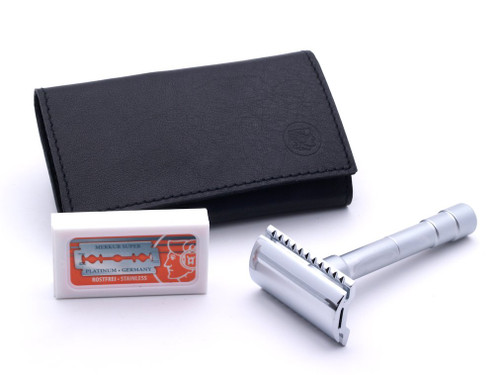
Description
Imported from Germany This Compact Handy Travel version of the Classic Double-Edge Razoris surprising in its level of Quality and Beauty. IncludesTop Grain Leather case that holds both the disassembled razor and spare blades. Easily fits into any pocket for that quick shave at the airport or highway rest area. As pleasing to see and hold as it is to use. One Super Stainless Blade Included. Replacements listed separately.
Merkur travel grooming set. Black cowhide leather case with chrome-plated straight cut safety razor, detachable handle, and one pack of blades. These pieces are made by Solingen master grinders under most rigid control, from the finest, hot forged special steel. Made in Solingen, Germany
Write a Review
- Create New Wish List

Travel Double Edge Safety Razor Showdown Gillette Tech, Merkur 45C, Parker A1R

Merkur Safety Razor Solingen Wetshaving Supplies Spotlight by Razor Emporium
Related products.

Merkur Travel DE Safety Razor w/ Travel Case

Simpsons Travel Case for Shave Brush or Stick Small

Simpsons Travel Case for Shave Brush or Stick Large
Join our newsletter.

Razor Emporium
210 S 37th St Phoenix, AZ 85034
Mon - Sat 9:30a-4:30p MT

© 2024 Razor Emporium
- Search forums
- General Shaving Talk
- Safety Razors
- Double Edged Razors
Merkur Travel Razor
- Thread starter huck1680
- Start date May 30, 2022
- May 30, 2022
Gentlemen Just wanted to share a razor set with you. The Merkur 46C 3-piece travel razor. This is a very well made, excellent razor, not just for travelling but also for everyday usage. Because of carry-on restrictions, a lot of us have had to eschew taking our DE razors with us, if you do not check in your luggage while travelling. Well, that’s kinda too bad, considering most of us prefer shaving traditionally and to go back to CARTS is not that gratifying even while going abroad. Now, we go to our cabin as often as we can and because it’s a 4 hour drive, I always take my DE with me. In this case its the Merkur travel set. A truly wonderful, efficient and space saving razor. The handle breaks down, the head is a two-piece and there’s a slot for a tuck of blades. The shave is great. A very efficient, irritation-free and mild shaver. I like PolSilvers, Super-Iridiums and at times Voshkods, Personnas and the odd Astras. This razors handles them all with no fuss and a great deal of ease. Even some of the sharpest blades are easy and rewarding to use. So if you are travelling and if you driving, this is a great razor to take along. Also, if you’re flying, check your bag just so you can take this set up with you. We are going to see the Open in St. Andrews this July and this is the razor that’s going with me.
I've seen that set. Looks really nice. Decent price too.
Star_Wahl_Clipper_Treker
Likes a fat handle in his hand.

- Jun 1, 2022
- Thread starter
Star_Wahl_Clipper_Treker said: Posting a picture of your new kit would be a great idea, I had a heck of a time finding this. Merkur doesn't even sell this razor anymore. They have a 47C now. Anyways, your kit is probably this one, if not, again, a picture would be greatly appreacited. View attachment 1464370 Click to expand...
Similar threads
- Mar 31, 2024
- Shave of the Day!
- Mar 12, 2024
- Feb 19, 2024
- General Shaving Discussion
- Jan 21, 2024
- Jan 6, 2024
- The Barber Shop
- Style chooser
- Lights off!
- Change width
- Terms of Use
- Privacy policy
Your cart is empty
Have an account?
Log in to check out faster.
Shopping Cart (0)
FREE SHIPPING on Orders of $20+ Learn More

Merkur Travel Shaving Set in Camel Leather Case
- --> Open media 1 in modal
- --> Open media 2 in modal
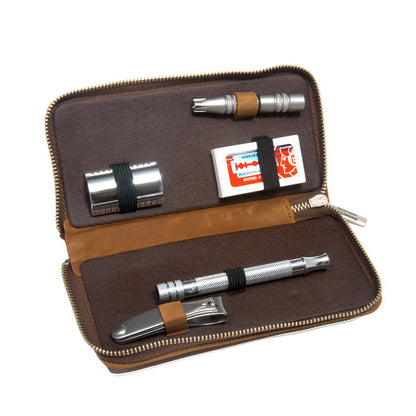
MSRP: $250.00
Couldn't load pickup availability
Why you'll love it
- Authorized Retailer
- exceptional customer service
- Free Shipping on All Orders Over $20
- Hassle-Free 90 Day Returns
- Over 24,000 Verified Customer Reviews
- Description
- Accessories
The Merkur Travel Set in Camel Leather Case is an ideal gift idea for the man on the go. This deluxe kit includes the Merkur 23001 Double Edge Safety Razor, Merkur Stainless Razor Blades, Dovo Klipette Nose Hair Trimmer, and a set of Nail Clippers. The sophisticated Camel Leather case zips closed to keep all these tools safely together.
The Merkur Double Edge Safety Razor features an extra long handle with a non-slip grip that provides a consistently close shave. The bar-chrome styled head uses standard double-edged razor blades and 3 piece design. This Safety Razor is the perfect choice for gentlemen with larger hands and fingers who want the control, but just need more handle room! Perfect balance and weight make this double-edge safety razor a joy to shave with.
Engraving: The leather case of this elegant Merkur travel set can be custom laser engraved.
Size: 4" Weight: 1/7 oz.
About Merkur Merkur was founded in 1896 by Emil Hermes in Solingen, Germany, but because there were already other cutlery companies in Solingen with the name of Hermes, Emil registered the brand name as MERKUR. Over the years, MERKUR has patented several of its models. Following the early death of his father, Hans Hermes, Dietrich Hermes ran the business during the years of the " economic miracle " together with his uncle Erich Hermes. After Erich's death in the 1970s, Dietrich sold the company MERKUR Stahlwaren to its biggest client, DOVO. Since then, the traditional production of double edge blade razors carrying the brand name MERKUR has continued under the same roof as the equally traditional production of straight razor from DOVO.
Made in Solingen, Germany
Merkur Super Platinum Double-Edge Safety Blades - 10 Blades/Pack
Lea classic shaving cream, you may also like.

Join Our Insider Email List
Join our insider email list for free engraving on an item in first order (value: $6.95), and be the first to receive exclusive deals, news and more.
- Choosing a selection results in a full page refresh.
- Opens in a new window.
Search search_icon Free Shipping for orders over $50
Featured products.


Merkur - 33C DE Safety Razor Starter Set includes Badger Shave Brush, Mug, Soap and Blades

Merkur - 34C Heavy Duty DE Safety Razor Starter Set includes Badger Shave Brush, Mug, Soap and Blades

Merkur - 34G (Gold) Heavy Duty DE Safety Razor Starter Set includes Badger Shave Brush, Mug, Soap and Blades

Merkur - FUTUR 700 Adjustable (Brushed) DE Safety Razor Starter Set includes Badger Shave Brush, Mug, Soap and Blades
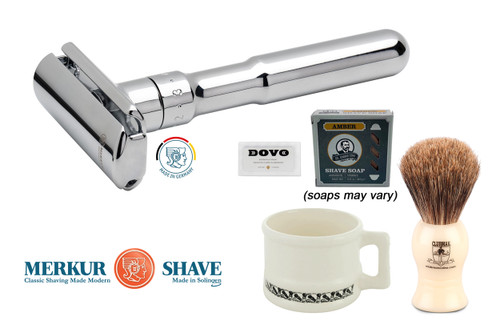
Merkur - FUTUR 701 Adjustable (Polished) DE Safety Razor Starter Set includes Badger Shave Brush, Mug, Soap and Blades

Merkur - FUTUR 702 Adjustable (Gold) DE Safety Razor Starter Set includes Badger Shave Brush, Mug, Soap and Blades
Safety razors.
Classic razors made modern
How to Guides
How to choose a safety razor
Shaving Accessories
Finish the job in style
Grooming Tools
The right tool for the job

MERKUR. Classic shaving
“This razor is perfect because of its fine craftsmanship and weight. I also appreciate that this razor, my second of the same model bought 10+ years earlier, came with very helpful care instructions … I find this razors weight to be helpful, because it feels like an extension of my hand, and also discourages quick movements that can result in cuts.”
“The Merkur Razor is a serious enough investment that I purchased a case, as soon as they became available. The case is very well made; the material is durable; and the case should last.“
“MERKUR - PROGRESS is amasing razor. Great quality and price for the set with carrying case and 10 blades.”
A RAZOR FOR ALL PURPOSES
- International edition
- Australia edition
- Europe edition
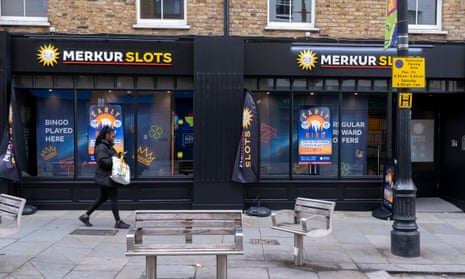
Slot machine operator being investigated over cancer patient’s activity
Staff at Merkur’s Stockport branch reportedly looked away as customer lost £2,000 over two days of play
The high street slot machine company Merkur is under investigation by the Gambling Commission over its alleged exploitation of a vulnerable customer, the Guardian understands, casting a shadow over its UK expansion drive.
The German-owned company operates Britain’s second-largest network of “adult gaming centres”, increasingly popular venues often open 24 hours a day, where customers can play £2 a spin slot machines.
The Guardian revealed in March that staff at Merkur’s Stockport branch looked on as Wendy Hughes, 64, who was being treated for lung cancer at the time, lost more than £2,000 over the course of 16 hours, spread across two days of play.
Staff reserved her favourite slot machine for her when, despite her physical frailty, she went out at midnight to fetch more money when her cash machine withdrawal limit reset.
The Gambling Commission, which can impose financial penalties on companies that break the terms of their gambling licence, is now understood to be investigating the case.
Merkur has blamed the incident on branch staff, saying that customer protection measures required by the regulator were “fully in place”.
In accounts filed at Companies House, Merkur reported revenues up 17% to £202m last year, as it reaped the benefit of a UK expansion project. It has opened 100 new venues since 2020.
Owned by Germany’s Gauselmann Group, Merkur nowhas 228 sites in the UK, making it the industry’s second-biggest player behind Admiral Slots, owned by the Austrian gaming firm Novomatic.
In its results, Merkur did not mention an investigation by the Gambling Commission; the regulator declined to comment on individual cases.
But in a longer-than-usual section of its results statement dedicated to regulatory risk and social responsibility, the company highlighted the potential damage to its business from “negative publicity”.
It said some in society and politics “perceive the gambling industry in a concerned light”, and that it would “provide and promote an environment in which customers play safely”.
Despite its rising revenues, investment in UK expansion has led to Merkur losing more than £9m over the past two years. The company said that, while it is still expanding, it will focus more on making new venues profitable, highlighting that new slot machine venues take at least a year to start making money.
after newsletter promotion
The results, and the Gambling Commission’s investigation, come at a sensitive time for Merkur and the wider slot machine sector. The company’s plan to expand its presence on British high streets has sometimes been met with local opposition, including in Sheffield, where the company recently withdrew its application for a new premises in the face of objections from residents.
Despite announcing plans to crack down on the digital slot machines sector earlier this year by reducing maximum stakes to £5, or £2 for those aged 18 to 24, the government is expected to loosen regulations governing high street slots.
Under proposals outlined as part of the government’s white paper on gambling reform , venues are likely to be allowed to stock a higher proportion of £2-a-spin machines relative to the number with maximum stakes of £1.
Merkur did not respond to requests for comment. The Gambling Commission does not confirm or deny whether it is investigating individual operators.
- Travel & leisure
Most viewed
- Forms & Rules
- Policy & Administration
- News & Reference
- Access to Electronic Court Case Records
- Public Records
There are three ways to look at court case records:
- Go to the courthouse and ask to look at paper case records.
- Go to the courthouse and look at electronic case records.
- If your court offers it, look at electronic case records over the internet. This is called “remote access.”
This page is about courts’ electronic case records and tells you:
- WHAT is an electronic case record,
- WHO can look at an electronic case record, and
- HOW to look at an electronic case record.
If your court does not keep electronic case records, you will need to go to the courthouse in person to look at paper case records.
- Find Your Court
For jury duty, traffic tickets, or local court information, find your trial court:
For jury duty, traffic tickets, or local court information, find your superior court here .
What is an electronic court case record?
When someone files a case in court, the court will keep an official record about the case. The official court record consists of f papers and materials filed in the case. Information about you may be contained in a court case record. For example, if you file a lawsuit claiming another person owes you money, your name and how much money you are asking for will become part of the court case record.
A court may keep a case record in paper or electronic format. A case record kept in electronic format is known as an electronic record. An electronic case record can only be viewed on an electronic device such as a computer, tablet, or cell phone. Not all court case records are available electronically and access to electronic court case records is controlled by law.
Who can look at electronic court case records?
The public is allowed to look at most court case records. However, there are some court case records the public may not see. Some laws, rules of court, and court orders make some case records confidential.
Examples of confidential case records include records filed in “juvenile dependency” cases (when a child is removed from their parents) and “juvenile delinquency” cases (when a child is accused of committing a crime). Court case records for these cases are not available to the public.
In other court cases, there are certain records in the case file that are not available to the public. An example of these is a fee waiver application. The public may be able to see part of the court case file but would not be able to see this record.
Even when the public is not allowed to look at a court case record, there will still be certain people who are allowed to do so. For example, if you are a party in a case, you can look at the court case record even if the public cannot.
How can I look at an electronic court case record?
There are two ways to look at electronic court case records:
- On a computer at the courthouse.
- On a computer, tablet, or smart phone anywhere with an internet connection, such as your home, or the public library. This is known as “remote access.”
How you can access an electronic court case record depends on your relationship to the case. If you are a party to a case, you have full remote access to those case records. If you are a member of the public, there may be limits on what you can see through remote access.
Remote Access by the Public
A court that keeps electronic case records must allow the public to see them at the courthouse. If it is feasible for a court to do so, the court also must allow the public remote access to some electronic case records.
Not all court case records are available to the public from locations outside the courthouse (remote access). For example, in sensitive cases such as divorce, child custody, civil harassment, and criminal, courts may only make available on the internet the registers of action, calendars, and case indexes. The public may only view other records filed in those cases at the courthouse. This strikes a balance between the public’s right to know about court business and individual privacy rights of the people involved in these cases.
For example, if you saw a news story about a criminal trial and wanted to look at the court’s electronic record about the case to find out more, you would need to visit the courthouse and see the electronic case record there. In some special situations, where there is an unusually high level of public interest in a criminal case, a judge may allow remote access to a criminal case electronic record. But this is not typical. Normally, you would need to visit the courthouse.
As another example in a divorce proceeding, information about you and your marriage could be included in an electronic case record. But the public could not look at the electronic case record using remote access. Members of the public who wanted to see the electronic case record would have to visit the courthouse to do so.
For a complete list of case types in which the public may only view electronic records at the courthouse, see rule 2.503 of the California Rules of Court.
Keep in mind too that all or part of a court case record may be confidential by law or sealed by court order. If so, no member of the public may view the electronic case record, either at the courthouse or through remote access.
Remote Access to Case Records by Parties and Other People Related to the Case
Certain people, such as a party or a party’s attorney can always use remote access, if available, to look at the full electronic court case record.
The sections below will give you more information about the people who can have full remote access to electronic case records. The sections below only apply if the court is able to provide remote access. Not every court may be able to provide remote access. Even courts that are able to provide it may not yet be able to provide it to everyone listed below.
- Party — If you are a party, you can use remote access to look at electronic records of your case. The other party in your case can also look at the electronic case records.
- Person Authorized by a Party — If you are a party and you need another person’s help, you may want that person to use remote access to look at electronic records of your case. If so, you can authorize that person to do so. This does not apply to electronic records of criminal, juvenile justice, or child welfare cases. It also does not apply to confidential electronic case records. Even if you are a party in those kinds of cases, you cannot authorize just anyone to look at the electronic case record. If you have an attorney, however, your attorney will be able to see and access the electronic case record.
- Party’s Attorney — If you are a party and you have an attorney, your attorney may use remote access to look at the electronic records in your case. If your attorney works in an organization such as a law firm or public defender’s office, other people working in the organization may also use remote access to view the electronic case records. This is only if they are assisting your attorney with your case. Paralegals, legal secretaries, interns, and other attorneys are all example of people who may be assisting your attorney with your case.
- Court-appointed People — Sometimes the court will appoint people to participate in a case who are not a party’s attorney. For example, a child’s interests can be affected by a case even if the child is not a party. If so, the court may appoint someone to look out for the child’s interests. As another example, the court may appoint an investigator to find information. In situations where the court has appointed a person to participate in a case, that person is allowed to use remote access to view electronic case records to fulfill the responsibilities the court assigned.
- Legal Aid Staff — Sometimes legal aid organizations have lawyers represent parties before a court. When that happens, the legal aid lawyer, just like any lawyer representing a party, is allowed to use remote access to look at the electronic records in the party’s case. Often though, legal aid organizations may provide more limited scope services, like a brief consultation, help understanding the procedures in a case, and help with forms and documents. If you go to legal aid for help with your case, the legal aid staff may be authorized to use remote access to look at the electronic records in your case with your consent.
- Government Staff — State and local government agencies often need staff to view court case records in the performance of government functions. Staff from these agencies may be authorized to view case records using remote access. For example, a city police department or county probation department may need to look at electronic case records in criminal matters. For a list of state and local government agencies and the types of electronic case records their staff may view using remote access, see rule 2.540 of the California Rules of Court.
Related Links
- Small Claims

Merkur Plastic Travel Case for Progress and Other Razors.
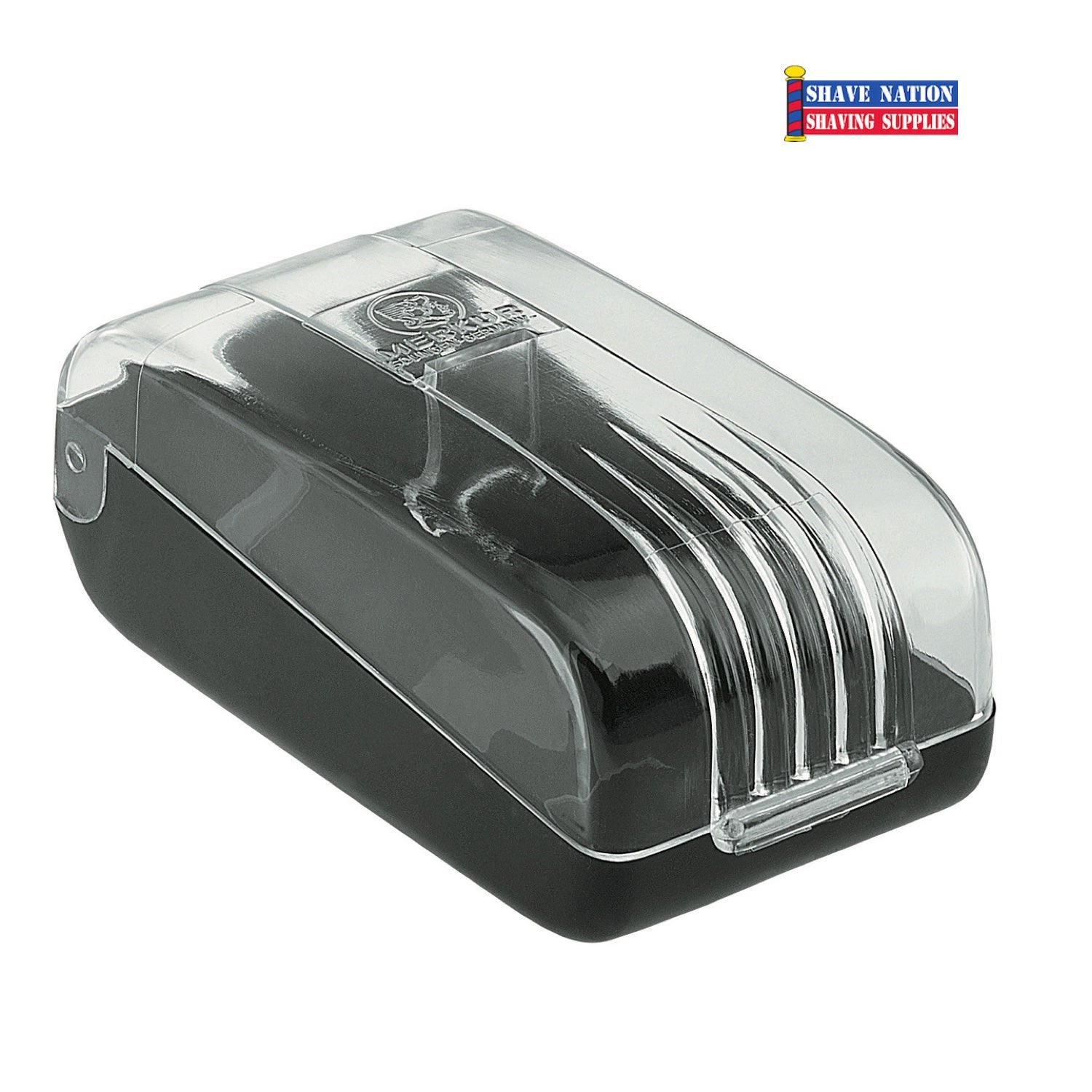
Your wishlist has been temporarily saved. Please Log in to save it permanently.
This stylish Merkur embossed plastic case will fit the shorter handled Merkur razors:
- Merkur Progress 500 Standard Handle (not the long handle)
- Merkur HD 34C
- Merkur Slant 37C
- Merkur 1904 - 41C or 42C
Can store 2 packs of razor blades along with the razor. An ideal way to store your razor and blades at home and on the road.
*Razor and blade packs not included-shown for display only*
SHAVE NATION ITEM NUMBER: SN1045
Customer Reviews
You may also like....

Volume 27, Number 5—May 2021
Epidemiologic Findings from Case Investigations and Contact Tracing for First 200 Cases of Coronavirus Disease, Santa Clara County, California, USA
Author affiliations: Centers for Disease Control and Prevention, Atlanta, Georgia, USA (N. Ortiz, J.T. Lee, K.L. Bajema, J.N. Ricaldi, M. Cortese, A.E. Barskey, J.F. Da Silva, M. Fischer, S.J. Chai) ; County of Santa Clara Public Health Department, San Jose, California, USA (E. Villarino, S. Smith, W. Lin, B.J. Bonin, S.L. Rudman, G.S. Han, S.H. Cody)
Cite This Article
In January 2020, Santa Clara County, California, USA, began identifying laboratory-confirmed coronavirus disease among residents. County staff conducted case and contact investigations focused on households and collected detailed case demographic, occupation, exposure, and outcome information. We describe the first 200 test-positive cases during January 31–March 20, 2020, to inform future case and contact investigations. Probable infection sources included community transmission (104 cases), known close contact with a confirmed case-patient (66 cases), and travel (30 cases). Disease patterns across race and ethnicity, occupational, and household factors suggested multiple infection risk factors. Disproportionately high percentages of case-patients from racial and ethnic subgroups worked outside the home (Hispanic [86%] and Filipino [100%]); household transmission was more common among persons from Vietnam (53%). Even with the few initial cases, detailed case and contact investigations of household contacts capturing occupational and disaggregated race and ethnicity data helped identify at-risk groups and focused solutions for disease control.
On January 31, 2020, the Santa Clara County Department of Public Health (SCCDPH) in San Jose, California, USA, identified its first case of coronavirus disease (COVID-19) in a resident who had recently returned from Wuhan, China ( 1 ). On February 28, the county reported its first case of COVID-19 associated with probable community transmission, 48 hours after the first presumed community-acquired case in the United States was identified 91 miles north in Solano County ( 2 ). Staff of the SCCDPH, the California Department of Public Health, and the Centers for Disease Control and Prevention (CDC) began conducting detailed interviews with each case-patient or their surrogate to identify, quarantine, and monitor close contacts, and isolate and test those who were symptomatic. Santa Clara initiated a series of community mitigation strategies to slow the spread of the virus that causes COVID-19, severe acute respiratory syndrome coronavirus 2 (SARS-CoV-2), including canceling large gatherings ( 3 , 4 ). On March 16, Santa Clara and 5 adjacent San Francisco Bay Area counties became the first US region to implement shelter-in-place orders requiring all residents to limit activity outside of their home and to order nonessential businesses and operations to close ( 5 ). SCCPHD collected detailed information on demographic characteristics to help identify communities at risk and those disproportionately affected by COVID-19. Since the initial identification of cases, surges in COVID-19 incidence have often constrained public health and community capacity to respond, including overwhelming case and contact investigation efforts. We describe the epidemiology of the first 200 COVID-19 cases reported to SCCPHD to identify key transmission factors that could already be identified early in the COVID-19 pandemic through detailed case investigation and contact tracing focused on households and to demonstrate the utility of focusing these efforts throughout the pandemic response.
Case Identification and Testing
We defined a confirmed COVID-19 case as an illness in a resident of Santa Clara County with SARS-CoV-2 detected by reverse transcription PCR (RT-PCR) on a nasopharyngeal or oropharyngeal swab specimen by a public health, hospital, or reference clinical microbiology laboratory or CDC. Testing was recommended in line with the following evolving CDC Person Under Investigation case definition: clinical findings of lower respiratory illness and travel to a Wuhan, China (later expanded to all of China) or an epidemiologic link to a laboratory-confirmed COVID-19 case ( 6 , 7 ); hospitalization for severe respiratory disease and no alternative diagnosis ( 8 ); and clinically compatible illness regardless of travel or known contact with a confirmed case-patient. Included COVID-19 case-patients comprised those reported to SCCDPH and those identified by a community-based sentinel surveillance project for COVID-19 conducted during March 5–14, 2020, among clinic patients with respiratory illness who tested negative for influenza virus ( 9 ). This activity was reviewed by CDC and was conducted consistent with applicable federal law and CDC policy.
Case Investigation and Contact Tracing
SCCDPH, California Department of Public Health, and CDC staff identified cases reported to California’s electronic reportable disease system. Staff interviewed COVID-19 cases or their surrogates for information on case age, sex, race, ethnicity, address, occupation, travel history, known contact with another confirmed case-patient, symptom onset (earliest of any symptoms listed on CDC’s standardized case report form) ( 10 ), and hospitalization. Investigators collected detailed race and ethnicity data, including racial subgroup among case-patients reporting Asian ancestry.
Case-patients with no recent travel and no known close contact with another confirmed case-patient in the 2 weeks before symptom onset were classified as probable community transmission. Known close contact was defined as living with, caring for, working with, transporting, or prolonged exposure (close contact <6 feet for > 30 minutes) to a person with confirmed COVID-19. Case-patients with any travel outside of Santa Clara County in the 2 weeks before their symptom onset were considered travel-associated cases.
SCCPHD’s contact tracing involved identifying persons with close contact with the case-patient 2 weeks after the case-patient’s symptom onset and notifying contacts of their exposure. Owing to the rapid rise in case counts and limited personnel capacity, the team focused on following up with household contacts. In-hospital outcomes were collected from review of medical records and case-patient interviews. Deaths through May 20, 2020 (60 days after the 200th case was reported), were defined as COVID-19–associated if the cause or other contributing cause on the death certificate was listed as COVID-19.
Data Analysis
We collected data using standard forms and open-ended case-patient interviews and entered results into Excel 365 (Microsoft, https://www.microsoft.com ) and California’s electronic reportable disease system. Categorical variables were described as counts and percentages, and continuous variables were described using median and range. We estimated associations between illness severity measures (hospitalization defined as admission for > 1 night in an inpatient acute-care facility [including intensive-care unit (ICU) stay and mechanical intubation with ventilation]; ICU stay [including mechanical ventilation]; mechanical ventilation; and death) as the dependent variables, and age and sex as independent variables with odds ratios (ORs) and 95% CIs using bivariate logistic regression. Because of the limited number of cases, to avoid invalid results or unstable models, measurements were not adjusted. We analyzed data using Stata 14 (StataCorp, https://www.stata.com ) and Epi Info version 7 (Epi Info, https://www.cdc.gov/epiinfo ) and generated maps using Excel 365 (Microsoft, https://www.microsoft.com ).
Case Description

- Figure 1 . Week of symptom onset, for first 200 confirmed coronavirus disease cases, by exposure source, Santa Clara County, California, USA, January 31–March 20, 2020.
Of the 200 cases with laboratory confirmation of SAR-CoV-2 positivity during January 31–March 20, 2020, a total of 191 (96%) were identified through routine surveillance and contact tracing and 9 (4%) were identified through clinic-based sentinel surveillance. Onset of illness ranged from January 24 through March 18; these case-patients were exposed before shelter-in-place orders were invoked ( Figure 1 ). Among the first cases identified during January 31–February 2, travel accounted for the largest reported source of exposure. Over subsequent weeks, case-patients reported unknown and household exposure at higher frequencies than other exposures. The percentage of case-patients who were hospitalized decreased over time as testing availability increased and focus of testing broadened to include additional populations, including symptomatic contacts.

Figure 2 . Hospitalization status and outcomes, for first 200 confirmed coronavirus disease cases, by age group, Santa Clara County, California, USA, January 31–March 20, 2020. Outcomes are classified by most severe status...
Among the 200 case-patients, 112 (56%) were male, and the median age was 50 years (range 6 months–94 years); only 10 (5%) case-patients were <20 years of age, whereas 71 (36%) were > 60 years of age ( Table ). The racial and ethnic distribution of case-patients was similar to that of the county population overall: 70 (35%) reported as Asian, 52 (26%) Hispanic, 52 (26%) White non-Hispanic, 4 (2%) Black non-Hispanic, and 3 (1%) Pacific Islander; race or ethnicity was unknown for 19 (9%) case-patients. Although Asian-identifying persons comprised a similar proportion of case-patients as that of Santa Clara County, a higher proportion of case-patients identified as Filipino (10% vs. 5%), a similar proportion as Vietnamese (7% vs. 7%), and a lower proportion as Indian (4% vs. 9%) or Chinese (4% vs. 10%) than among the general population of Santa Clara County ( 11 , 12 ). Of the 200 case-patients, 89 (44%) were hospitalized ( Table ); 45 (23%) were on a general ward, 18 (9%) were admitted to an ICU without requiring mechanical ventilation, and 26 (13%) required mechanical ventilation in an ICU. The proportion of case-patients hospitalized, admitted to the ICU, requiring mechanical ventilation, and who died each increased with increasing age ( Figure 2 ). Compared with case-patients <60 years of age, case-patients > 60 years of age had higher odds of hospitalization (OR 4.4 [95% CI 2.4–8.3]), ICU stay (OR 10.9 [95% CI 4.9–24.2]), mechanical ventilation (OR 6.3 [95% CI 2.5–16.0]), and death (OR 9.0 [95% CI 2.9–28.4]). No statistically significant association was observed between clinical outcomes and sex.
Among the 200 case-patients, 20 (10%) had a matching death certificate. The median age of deceased case-patients was 70.5 years (range 42–87 years), and 15 (75%) were male. Among the 20 case-patients who died, 9 (45%) were Asian, 5 (25%) were White non-Hispanic, 2 (10%) were Hispanic, and 4 (20%) had unknown race or ethnicity. Five (25%) of the 20 deaths occurred among persons of Filipino ethnicity; these case-patients did not have a known close contact to one another.

Figure 3 . Geographic location of first 200 confirmed coronavirus disease cases, by case-patient’s ZIP code area of residence (for those areas with >2,000 residents), Santa Clara County, California, USA, January 31–March 20,...
Case-patient residences were distributed among 47 (79%) of the 59 ZIP codes in the county; 18 (30%) ZIP codes had 1–2 cases, 13 (22%) had 3–4 cases, and 16 (8%) had > 5 cases ( Figure 3 , panel A). Case-patient residences clustered in the northeastern part of the county, where 2 adjacent ZIP codes accounted for 36 (18%) of the 200 case-patients; in the ZIP code with the most cases, 9 were associated with a single household. COVID-19 incidence rates by ZIP code ranged from 0–113 cases/100,000 persons; rates were generally highest in eastern ZIP codes in the county ( Figure 3 , panel B).
Exposure Type and Setting
Of the 200 case-patients, 66 (33%) had known close contact with another confirmed case-patient, 30 (15%) were considered travel-associated cases ( Table ), and 104 (52%) were attributable to probable community transmission. Among the 66 case-patients with known close contact with another confirmed case-patient, 49 (74%) were exposed to a household member, and 17 (26%) had occupational exposures. Most households with evidence of transmission (13/15 [86%]) had 2–3 confirmed case-patients identified. However, 2 multigenerational households each had 9 and 4 case-patients; the cluster of 4 case-patients was only identified as a result of contact tracing.
Of the 200 case-patients, 159 (79%) were adults with reported occupation. Of these, 111 (69%) were actively employed (not retired and reported employment), and of these, 82 (73%) reported jobs requiring work outside the home, which included healthcare workers, firefighters, food service workers, retail employees, construction workers, housekeepers, and other workers. Among these 82 case-patients reporting jobs requiring work outside the home, 46% of exposures were attributable to probable community transmission, followed by 22% household and 21% occupational exposures.
Type and location of exposure, as well as having an occupation that requires work outside the home, varied by race and ethnicity. Among 49 cases in Hispanic adults, occupation was known for 44 (89%); of the 38 actively employed, 89% held occupations that required them to work outside of the home. Occupation was known for 16 of 20 Filipino case-patients; for the 9 case-patients who were actively employed, all had jobs outside the home. Occupational exposure to a confirmed case-patient, including in a healthcare setting, accounted for 5 (25%) of 20 cases in Filipino persons, compared with 12 (7%) of all other cases with reported race and ethnicity. Household transmission accounted for exposures in 53% of Vietnamese case-patients and 32% of Hispanic case-patients, compared with 23% of all other case-patients with known race/ethnicity. Among case-patients of Indian and Chinese ethnicity, >50% had travel-related exposures.
Among the 17 case-patients with an occupational exposure to a confirmed case-patient, 11 (64%) exposures occurred in a nonhealthcare setting. Of these 11, all were employed as essential workers in occupations or settings in which they had frequent contact with many persons in the community. Occupational clusters and groupings included 6 airport employees, 4 employees at a supermarket, 3 childcare workers who shared a classroom and bathroom, and 2 firefighters who worked at the same station. At least 3 additional cases were identified among other firefighters who worked at the same station or attended a common function but were not Santa Clara County residents.
Of the 200 case-patients, 16 (8%) were healthcare workers with jobs that provided direct patient care or were first responders with direct patient exposure, of whom 8 (50%) were nurses. Only 6 transported, cared for, or had other known close contact with a confirmed case-patient in a healthcare setting. Of the other 10 cases in healthcare workers, 1 case-patient had travel-related exposure, 3 had known close contact with a case-patient in their household, and 6 did not have exposure to a known COVID-19 case-patient and were categorized as attributable to probable community transmission.
Detailed case investigations and household contact tracing of the first 200 case-patients of COVID-19 in Santa Clara County were able to help elucidate factors associated with being a COVID-19 case-patient and identify populations at risk for infection early in the response, including possible racial and ethnic disparities, elevated risks within households, and high-risk occupational groups. Many of these factors and populations at risk were subsequently confirmed by studies later in the pandemic ( 13 , 14 ). Case investigations identified possible sources of transmission in 96 (48%) of cases, and for those case-patients with known exposure, household transmission was the most commonly reported source, especially in Vietnamese and Hispanic communities. Work outside the home was commonly reported by Hispanic case-patients. Case-patients > 60 years of age had significantly higher odds of being hospitalized, being admitted to the ICU, requiring mechanical ventilation, and dying; these findings are consistent with reports from China, Italy, and other parts of the United States ( 15 – 17 ).
Because SCCPHD conducted contact tracing and monitoring specifically among household contacts of case-patients, the finding that approximately one quarter of the first 200 case-patients were household contacts of a confirmed case-patient is not surprising. However, SCCPHD’s prioritization of contact tracing and monitoring contacts within households early in the pandemic was high-yield, and findings were consistent with disease transmission factors for COVID-19 reported in subsequent studies ( 18 , 19 ). Investigations identified not only that older persons had increased odds of poor outcomes from COVID-19 but also that case-patients with multiple factors potentially increased risk. For example, several large clusters were identified within families that consisted of members of multiple generations, and several individuals >80 years of age might have been exposed. In 2 of these clusters, the index case-patient was a nonelderly household member who presumably transmitted SARS-CoV-2 to elderly household members. Anecdotally, several of these households also reported crowding and inability to self-isolate from other members within the home (Santa Clara COVID-19 Case Investigation Team, pers. comm., group discussion during case review, March 2020). Households have been identified as a high-risk setting for SARS-CoV-2 transmission ( 20 – 22 ), and household crowding is a risk factor for COVID-19 ( 23 ). In the ZIP code with the highest case rate in northeast Santa Clara, 14% of households are overcrowded (>1.0 persons/room), as measured by the American Community Survey, compared with the median of 6% of households in Santa Clara County as a whole ( 24 ). Although information on an individual case-patient’s household density was not collected as part of case and contact investigations, 4 (33%) of 12 ZIP codes where household transmission was identified reported >10% frequency of overcrowded households, compared with 7 (20%) of 35 ZIP codes where cases were identified but no household transmission was noted. Household density might be associated with other factors, such as high-risk occupations of household members ( 25 , 26 ), to increased risk for COVID-19 within households. Case investigators collecting information regarding household density during interviews can help not only to elucidate transmission risk in a particular household, but also link persons at high risk for poor outcomes to resources to prevent household transmission. One example of a solution to prevent household transmission is The NYC Test and Trace Corps, a collaborative public health program led by NYC Health + Hospitals in collaboration with the New York City Department of Public Health and Mental Hygiene, which offers hotel stays for persons who have COVID-19, exhibit COVID-19 symptoms, or are contacts of a known COVID-19 case-patient and who need to isolate or quarantine from household members ( 27 ).
Working outside the home, especially with public-facing duties (e.g., airport workers), was especially common in this early cohort; >40% of case-patients reported an occupation that did not allow them to work from home. A large frequency of case-patients who performed work outside the home did not report a known exposure or travel, suggesting that difficult-to-trace exposures, such as exposure to someone the case-patient did not know or did not know was infected, probably occurred ( 28 ). Moreover, occupational exposures were probably more common than we reported, because case-patients who did not have known exposure to a person with confirmed COVID-19 and had not traveled were classified as having community exposure. Identifying the source of exposure for case-patients with occupations that interact with the public might prove to be very labor-intensive or impossible, given the number of potential contacts involved. However, case and contact investigations, at a minimum, should include notifying co-workers and alerting employers to a positive case in a workplace ( 29 ) and collecting occupation data to help identify occupational subgroups at risk.
Occupational exposures probably differed by racial and ethnic groups among the first 200 case-patients in Santa Clara County. Among employed Filipino case-patients, all held jobs that required work outside the home. Although few Hispanic case-patients reported an occupational exposure with a confirmed COVID-19 case-patient, a greater percentage of Hispanic case-patients (89%) had occupations that required them to work outside the home than did White non-Hispanic case-patients (56%). Many of the Hispanic case-patients in Santa Clara County communicated that they could not afford the lost wages that would result from staying home from work (Santa Clara COVID-19 Case Investigation Team, pers. comm., group discussion during case review, March 2020). Hispanic persons nationwide have reported higher frequencies of job loss and wage reduction because of the COVID-19 pandemic compared with persons from other racial and ethnic minority groups, and less than one third of Hispanic persons surveyed reported that they could weather a financial emergency ( 30 ). These financial and occupational factors together might be critical drivers for transmission within the Hispanic population in Santa Clara County and perhaps statewide, where Hispanic persons have accounted for a disproportionately high number of cases ( 31 ). A disproportionately high percentage of COVID-19 cases and deaths occurred in Filipino persons; cases among Filipino persons associated with occupational exposures involved providing direct patient care to known COVID-19 patients or contact with a person with confirmed COVID-19 in public-facing service jobs.
Household exposures also differed by racial and ethnic groups. Vietnamese and Hispanic case-patients more frequently reported exposure to a person with confirmed COVID-19 in their household compared with case-patients from other race and ethnicity groups. Anecdotally, among Vietnamese and Hispanic case-patients, > 3 reported living in multigenerational households with high densities of persons and an inability to self-isolate within the home, posing a serious risk to older adults residing in these households. Household case clusters occurred in eastern ZIP codes that had high percentages of Hispanic persons (58% of the population in the ZIP code with the most cases and highest rates) and Vietnamese persons (22%), compared with 26% of Hispanic and 7% of Vietnamese persons in the county as a whole ( 32 – 37 ). Together, these findings suggest that household crowding might be an especially important driver of household transmission in traditionally underserved communities.
Few of the first 200 COVID-19 cases in Santa Clara County occurred in healthcare workers or persons in institutional or congregate living settings. Although more than one third of infected healthcare workers reported an occupational exposure and a quarter traveled or had a nonoccupational close-contact exposure, none of these exposures was identified for 40% of them. Evidence to date does not support substantial occupational transmission of SARS-CoV-2 to healthcare workers ( 38 ). Community transmission could have been an important source of exposure for healthcare workers, given the widespread community transmission occurring simultaneously in Santa Clara County.
One limitation of this analysis is, as with most reports on COVID-19, case identification was largely dictated by testing practices. At the start of the outbreak, the number of persons eligible for testing according to CDC criteria and testing capacity were limited, biasing these initial findings to case-patients with higher disease and mortality rates and to persons with recent travel or known contact with a confirmed case-patient. Had testing been more widely available and criteria included milder symptoms or risk for exposure regardless of symptoms, broader or earlier detection of community transmission might have occurred. This investigation occurred when information was limited for this new and emerging disease. The definition of prolonged COVID-19 exposure and guidance for case and contact investigations has been updated since this investigation concluded ( 39 ). Although we observed differences in sources of exposure by race and ethnicity, data on race were missing for 19 (9%) cases and racial subgroup for 16 (23%) of 70 cases among Asian persons; therefore, these data should be interpreted with caution. Our data reflect the epidemiology of COVID-19 in Santa Clara early in the pandemic among those with clinical manifestations that were eligible for testing and probably are not reflective of the current epidemiology ( 40 ).
Even with results from only the first 200 case-patients, detailed case investigation and contact tracing focused on households revealed patterns of at-risk populations, including older age adults, racial and ethnic subgroups, occupational categories, and potentially crowded households. Detailed case reviews, including disaggregation of race and ethnicity data, helped identify local factors of transmission and disparities important for public health intervention. Importantly, occupational exposures continue to be a source of infection ( 41 ), and understanding transmission risk within specific occupational settings, especially among professions that require persons to work outside their homes, is important to ensure safe workplaces and reopening of economies as the pandemic continues to evolve. As mitigation measures to suppress community transmission evolve throughout the pandemic response, novel preventive measures (e.g., temporary housing) might continue to be necessary to protect disproportionately affected subpopulations and older adults.
Dr. Ortiz is an Epidemic Intelligence Service Officer in the Division of Scientific Education and Professional Development, Center For Surveillance, Epidemiology, And Laboratory Services, Centers for Disease Control and Prevention.
Members of the Santa Clara County COVID-19 Case Investigation Team: Nora Chea, Calin Chiribau, Lindsey Duca, Joseph Hicks, Jimee Hwang, Jessica Leung, Joel London, Huong Pham, Matthew Stuckey, Diya Surie, Kathleen Thurman, and Douglas Trout.
Acknowledgment
We thank the Case Investigation Team for their support in the field.
- Santa Clara County Public Health Department . Letter from the Health Officer. February 3, 2020 [ cited 2021 Jan 28 ]. https://www.sccgov.org/sites/covid19/Pages/health-officer-letter-2-3-2020.aspx
- Santa Clara County Public Health Department . County of Santa Clara Public Health Department reports third case of COVID-19. February 28, 2020 [ cited 2021 Jan 28 ]. https://www.sccgov.org/sites/phd/news/Pages/third-novel-coronavirus-case-02-2020.aspx
- Santa Clara County Public Health Department . County of Santa Clara issues order to cancel mass gatherings due to increasing rates of COVID-19. March 9, 2020 [ cited 2021 Jan 28 ]. https://www.sccgov.org/sites/phd/news/Pages/order-health-officer-03092020.aspx
- Santa Clara County Public Health Department . Due to increasing rates of COVID-19, County Public Health issues new order cancelling gatherings of more than 100 people and restricting gatherings of more than 35 people. March 13, 2020 [ cited 2021 Jan 28 ]. https://www.sccgov.org/sites/phd/news/Pages/press-release-03-13-20.aspx .
- Santa Clara County Public Health Department . Seven bay area jurisdictions order residents to stay home. March 16, 2020 [ cited 2021 Jan 28 ]. https://www.sccgov.org/sites/phd/news/Pages/press-release-03-16-20.aspx
- Centers for Disease Control and Prevention . Health alert network: update and interim guidance on outbreak of 2019 novel coronavirus ( 2019 -nCOV) in Wuhan, China. 2020 [ cited 2021 Jan 28 ]. https://emergency.cdc.gov/han/han00427.asp
- Centers for Disease Control and Prevention . Health alert network: update and interim guidance on outbreak of 2019 novel coronavirus ( 2019 -nCOV) in Wuhan, China. 2020 [ cited 2021 Jan 28 ]. https://emergency.cdc.gov/han/han00426.asp
- Centers for Disease Control and Prevention . Update and interim guidance on outbreak of coronavirus disease 2019 (COVID-19). February 28, 2020 [ cited 2021 Jan 28 ]. https://emergency.cdc.gov/han/2020/han00428.asp
- Zwald ML , Lin W , Sondermeyer Cooksey GL , Weiss C , Suarez A , Fischer M , et al. Rapid sentinel surveillance for COVID-19—Santa Clara County, California, March 2020. MMWR Morb Mortal Wkly Rep . 2020 ; 69 : 419 – 21 . DOI PubMed Google Scholar
- Centers for Disease Control and Prevention . Human infection with 2019 novel coronavirus case report form [ cited 2021 Jan 29 ]. https://www.cdc.gov/coronavirus/2019-ncov/downloads/pui-form.pdf
- US Census Bureau . United States Census. Quick facts: Santa Clara County, California. July 1, 2019 [ cited 2021 Jan 28 ]. https://www.census.gov/quickfacts/santaclaracountycalifornia
- US Census Bureau . 2018 American Community Survey 5-year estimates, demographic and housing estimates, Table DP05 [ cited 2021 Jan 28 ]. https://data.census.gov/cedsci/table?g=0400000US06_0500000US06085&d=ACS%205-Year%20Estimates%20Data%20Profiles&tid=ACSDP5Y2018.DP05
- Figueroa JF , Wadhera RK , Lee D , Yeh RW , Sommers BD . Community-level factors associated with racial and ethnic disparities in COVID-19 rates in Massachusetts. Health Aff (Millwood) . 2020 ; 39 : 1984 – 92 . DOI PubMed Google Scholar
- Grijalva CG , Rolfes MA , Zhu Y , McLean HQ , Hanson KE , Belongia EA , et al. Transmission of SARS-COV-2 infections in households—Tennessee and Wisconsin, April–September 2020. MMWR Morb Mortal Wkly Rep . 2020 ; 69 : 1631 – 4 . DOI PubMed Google Scholar
- Grasselli G , Zangrillo A , Zanella A , Antonelli M , Cabrini L , Castelli A , et al. ; COVID-19 Lombardy ICU Network . Baseline characteristics and outcomes of 1591 cases infected with SARS-CoV-2 admitted to ICUs of the Lombardy Region, Italy. JAMA . 2020 ; 323 : 1574 – 81 . DOI PubMed Google Scholar
- Garg S , Kim L , Whitaker M , O’Halloran A , Cummings C , Holstein R , et al. Hospitalization rates and characteristics of cases hospitalized with laboratory-confirmed coronavirus disease 2019—COVID-NET, 14 states, March 1–30, 2020. MMWR Morb Mortal Wkly Rep . 2020 ; 69 : 458 – 64 . DOI PubMed Google Scholar
- Bialek S , Boundy E , Bowen V , Chow N , Cohn A , Dowling N , et al. ; CDC COVID-19 Response Team . Severe outcomes among cases with coronavirus disease 2019 (COVID-19)—United States, February 12–March 16, 2020. MMWR Morb Mortal Wkly Rep . 2020 ; 69 : 343 – 6 . DOI PubMed Google Scholar
- Qian G , Yang N , Ma AHY , Wang L , Li G , Chen X , et al. COVID-19 transmission within a family cluster by presymptomatic carriers in China. Clin Infect Dis . 2020 ; 71 : 861 – 2 . DOI PubMed Google Scholar
- Chan JF-W , Yuan S , Kok K-H , To KK , Chu H , Yang J , et al. A familial cluster of pneumonia associated with the 2019 novel coronavirus indicating person-to-person transmission: a study of a family cluster. Lancet . 2020 ; 395 : 514 – 23 . DOI PubMed Google Scholar
- Wang Z , Ma W , Zheng X , Wu G , Zhang R . Household transmission of SARS-CoV-2. J Infect . 2020 ; 81 : 179 – 82 . DOI PubMed Google Scholar
- Haroon S , Chandan JS , Middleton J , Cheng KK . Covid-19: breaking the chain of household transmission. BMJ . 2020 ; 370 : m3181 . DOI PubMed Google Scholar
- Lei H , Xu X , Xiao S , Wu X , Shu Y . Household transmission of COVID-19-a systematic review and meta-analysis. J Infect . 2020 ; 81 : 979 – 97 . DOI PubMed Google Scholar
- Emeruwa UN , Ona S , Shaman JL , Turitz A , Wright JD , Gyamfi-Bannerman C , et al. Associations between built environment, neighborhood socioeconomic status, and SARS-CoV-2 infections among pregnant women in New York City. JAMA . 2020 ; 324 : 390 – 2 . DOI PubMed Google Scholar
- US Census Bureau . Percentage of overcrowded housing units, 2014–2018 American Community Survey 5-year estimates. Table B25014 [ cited 2021 Jan 30 ]. https://data.census.gov/cedsci/table?q=B25014&tid=ACSDT5Y2018.B25014&hidePreview=false
- Ghinai I , Woods S , Ritger KA , McPherson TD , Black SR , Sparrow L , et al. Community transmission of SARS-CoV-2 at two family gatherings—Chicago, Illinois, February–March 2020. MMWR Morb Mortal Wkly Rep . 2020 ; 69 : 446 – 50 . DOI PubMed Google Scholar
- Centers for Disease Control and Prevention . Households living in close quarters. April 18, 2020 [ cited 2021 Jan 29 ]. https://www.cdc.gov/coronavirus/2019-ncov/daily-life-coping/living-in-close-quarters.html
- Test & Trace Corps . NYC Health + Health Hospitals. Take care [ cited 2021 Jan 29 ]. https://www.nychealthandhospitals.org/test-and-trace/take-care
- US Department of Labor, Occupational Safety and Health Administration . Safety and Health Topics. COVID-19. Hazard recognition [ cited 2020 Jul 13 ]. https://www.osha.gov/coronavirus/hazards
- Council of State and Territorial Epidemiologists Occupational Health Subcommittee . Recommended interim guidance for collecting employment information about COVID-19 cases [ cited 2021 Jan 28 ]. https://cdn.ymaws.com/www.cste.org/resource/resmgr/publications/Guidance_collecting_io_covid.pdf
- Pew Research Center . About half of lower-income Americans report household job or wage loss due to COVID-19. April 21, 2020 [ cited 2021 Jan 28 ]. https://www.pewsocialtrends.org/2020/04/21/about-half-of-lower-income-americans-report-household-job-or-wage-loss-due-to-covid-19
- California Department of Public Health . COVID-19 race and ethnicity data. June 7, 2020 [ cited 2021 Jan 28 ]. https://www.cdph.ca.gov/Programs/CID/DCDC/Pages/COVID-19/Race-Ethnicity.aspx
- Census Reporter . 95127. ZIP code tabulation area in: Santa Clara County, CA, San Jose-Sunnyvale-Santa Clara, CA Metro Area, California, United States [ cited 2021 Jan 28 ]. https://censusreporter.org/profiles/86000US95127-95127
- Census Reporter . 95148. ZIP code tabulation area in: Santa Clara County, CA, San Jose-Sunnyvale-Santa Clara, CA Metro Area, California, United States [ cited 2021 Jan 28 ]. https://censusreporter.org/profiles/86000US95148-95148
- Census Reporter. Santa Clara County. CA [ cited 2021 Jan 28 ]. https://censusreporter.org/profiles/05000US06085-santa-clara-county-ca
- Census Reporter . Race. American Community Survey 2018 5-year estimates. Table B02001 [ cited 2021 Jan 28 ]. https://censusreporter.org/data/table/?table=B02001&geo_ids=86000US95148&primary_geo_id=86000US95148#valueType|estimate
- US Census Bureau . Asian alone by selected groups. American Community Survey 2018 5-year estimates. Table B02015 [ cited 2021 Jan 28 ]. https://data.census.gov/cedsci/table?q=B02015&g=8600000US95148&tid=ACSDT5Y2018.B02015&hidePreview=false
- US Census Bureau . Hispanic or Latino origin by specific origin. American Community Survey 2018 5-year estimates. Table B03001 [ cited 2021 Jan 29 ]. https://data.census.gov/cedsci/table?q=Table%20B03001&tid=ACSDT5Y2018.B03001&hidePreview=false
- Kambhampati AK , O’Halloran AC , Whitaker M , Magill SS , Chea N , Chai SJ , et al. ; COVID-NET Surveillance Team . COVID-19-associated hospitalizations among health care personnel—COVID-NET, 13 states, March 1–May 31, 2020. MMWR Morb Mortal Wkly Rep . 2020 ; 69 : 1576 – 83 . DOI PubMed Google Scholar
- Centers for Disease Control and Prevention . Investigating a COVID-19 case [ cited 2021 Jan 29 ]. https://www.cdc.gov/coronavirus/2019-ncov/php/contact-tracing/contact-tracing-plan/investigating-covid-19-case.html
- Santa Clara County Public Health. County of Santa Clara Emergency Operations Center COVID-19 dashboards [ cited 2021 Jan 29 ]. https://www.sccgov.org/sites/covid19/Pages/dashboard-demographics-of-cases-and-deaths.aspx
- Fisher KA , Olson SM , Tenforde MW , Feldstein LR , Lindsell CJ , Shapiro NI , et al. ; IVY Network Investigators ; CDC COVID-19 Response Team . CDC COVID-19 Response Team. Telework before illness onset among symptomatic adults aged > 18 years with and without COVID-19 in 11 outpatient health care facilities—United States, July 2020. MMWR Morb Mortal Wkly Rep . 2020 ; 69 : 1648 – 53 . DOI PubMed Google Scholar
- Figure 2 . Hospitalization status and outcomes, for first 200 confirmed coronavirus disease cases, by age group, Santa Clara County, California, USA, January 31–March 20, 2020. Outcomes are classified by most severe...
- Figure 3 . Geographic location of first 200 confirmed coronavirus disease cases, by case-patient’s ZIP code area of residence (for those areas with >2,000 residents), Santa Clara County, California, USA, January 31–March...
- Table . Characteristics of first 200 confirmed COVID-19 case-patients, Santa Clara County, California, USA, January 31–March 20, 2020
DOI: 10.3201/eid2705.204876
Original Publication Date: April 01, 2021
1 Members of the Santa Clara County COVID-19 Case Investigation Team are listed at the end of this article.
Table of Contents – Volume 27, Number 5—May 2021
Please use the form below to submit correspondence to the authors or contact them at the following address:
Nancy Ortiz, Centers for Disease Control and Prevention, 1600 Clifton Rd NE, Mailstop V25-1, Atlanta, GA 30329-4027, USA
Comment submitted successfully, thank you for your feedback.
There was an unexpected error. Message not sent.
Exit Notification / Disclaimer Policy
- The Centers for Disease Control and Prevention (CDC) cannot attest to the accuracy of a non-federal website.
- Linking to a non-federal website does not constitute an endorsement by CDC or any of its employees of the sponsors or the information and products presented on the website.
- You will be subject to the destination website's privacy policy when you follow the link.
- CDC is not responsible for Section 508 compliance (accessibility) on other federal or private website.
Article Citations
Highlight and copy the desired format.
Metric Details
Article views: 2293.
Data is collected weekly and does not include downloads and attachments. View data is from .
Citations: 3
What is the altmetric attention score.
The Altmetric Attention Score for a research output provides an indicator of the amount of attention that it has received. The score is derived from an automated algorithm, and represents a weighted count of the amount of attention Altmetric picked up for a research output.

IMAGES
VIDEO
COMMENTS
Parker Safety Razor Double Edge Safety Razor Travel Case-Premium Leather Safety Razor Case, Snap-Lock Design-Compatible with Parker, Merkur, Gillette and All Other Standard Double Edge Safety Razors. 1 Count (Pack of 1) 802. $1399 ($13.99/count) Save more with Subscribe & Save. FREE delivery Tue, Jan 9 on $35 of items shipped by Amazon.
This plastic Merkur Travel Case is great for safe storage of your double edge razor. The case will be perfect for any razor that has a 3" handle or shorter. It is not limited to storing only Merkur razors. Some of the Merkur razors that fit are : - Merkur Progress 570. - Merkur HD 34C. - Merkur Slant 37C.
Merkur Double Edge Razor Travel Case. $35.99. 2 reviews. In stock and ready to ship. Add to Cart. Description. This travel razor, made of genuine top grade leather, will fit most Merkur classic or Futur razors and many other double edge razors. Black leather with a subtle DOVO/Merkur emblem snap. Made in Germany.
Merkur Futur Satin Chrome Travel Kit in Black Leather Zip Case Merkur Futur Travel Kit Includes: Futur Safety Razor in Brushed Satin Chrome Finish; 10 Pack of Merkur Blades; Black Leather Travel Zip Case; SHAVE NATION ITEM NUMBER: SN409. Customer Reviews. Based on 1 review Write a review.
Description. Accessories. The Merkur 3-Piece Travel Razor Set in Black Leather Case features a classic Merkur safety razor. The razor has a traditional head and a 3-piece design that can be used with all double edge standard blades. The beautiful chrome plated handle breaks down into 2 pieces to make it fit easily into leather traveling case.
The Merkur Travel Double-Edge Safety Razor & Case is perfect for the man on the move. FEATURES Folding razor Ideal for travel Razor features same head as Merkur HD and 38C Don't forget the blades! A razor blade sampler is the best way to determine which blade is best suited to individual skin types and razor types
Easily fits into any pocket for that quick shave at the airport or highway rest area. As pleasing to see and hold as it is to use. One Super Stainless Blade Included. Replacements listed separately. Merkur travel grooming set. Black cowhide leather case with chrome-plated straight cut safety razor, detachable handle, and one pack of blades.
Leather Razor Cover Leather Razor Sheath Travel Case Safety Razor Dublin English Tan Leather Made in USA. (170) $13.50. Travel Razor Tins - Large Size for Gillette TTO, 2 piece, Long handle 3 piece, Injector, and SE razors. Razor sets like the 6S and ATT.
In this case its the Merkur travel set. A truly wonderful, efficient and space saving razor. The handle breaks down, the head is a two-piece and there's a slot for a tuck of blades. The shave is great. A very efficient, irritation-free and mild shaver. I like PolSilvers, Super-Iridiums and at times Voshkods, Personnas and the odd Astras.
The Merkur 34C Razor is one of the most popular razors in the Merkur Lineup. Two Piece polished chrome razor is efficient and appealing to the eye. Handy plastic travel case with hinged lid for compact protection. 10 Merkur Super Razor blades. Uses all Standard DE Blades. Made in Solingen, Germany
The Merkur Travel Set in Camel Leather Case is an ideal gift idea for the man on the go. This deluxe kit includes the Merkur 23001 Double Edge Safety Razor, Merkur Stainless Razor Blades, Dovo Klipette Nose Hair Trimmer, and a set of Nail Clippers. The sophisticated Camel Leather case zips closed to keep all these tools safely together.
MSRP: $133.80. $129.95. Merkur - FUTUR 700 Adjustable (Brushed) DE Safety Razor Starter Set includes Badger Shave Brush, Mug, Soap and Blades. MSRP: $153.80. $139.95. Buy Now. Merkur - FUTUR 701 Adjustable (Polished) DE Safety Razor Starter Set includes Badger Shave Brush, Mug, Soap and Blades. MSRP: $153.80.
In accounts filed at Companies House, Merkur reported revenues up 17% to £202m last year, as it reaped the benefit of a UK expansion project. It has opened 100 new venues since 2020.
CRIMINAL CASE INFORMATION: An online searchable index of criminal cases (filed in 2004 or later) is available on the Case Information Portal. Case Information on CD - You can request a CD of case data from our public website - see requesting a CD of civil case data or criminal case data. Case documents (filings, etc.) are not available online.
Courts file orders and decisions. There are three ways to look at court case records: Go to the courthouse and ask to look at paper case records. Go to the courthouse and look at electronic case records. If your court offers it, look at electronic case records over the internet. This is called "remote access.".
This stylish Merkur embossed plastic case will fit the shorter handled Merkur razors: Merkur Progress 500 Standard Handle (not the long handle) Merkur HD 34C. Merkur Slant 37C. Merkur 1904 - 41C or 42C. Can store 2 packs of razor blades along with the razor. An ideal way to store your razor and blades at home and on the road.
Typically, the best first step is to look for information on the court's website. Go to the court's website where the case is filed. Most courts have a section on their website called " online services " or something similar. There you will find information about whether you can look up a court case online and what type of records you can see.
Case-patients with any travel outside of Santa Clara County in the 2 weeks before their symptom onset were considered travel-associated cases. SCCPHD's contact tracing involved identifying persons with close contact with the case-patient 2 weeks after the case-patient's symptom onset and notifying contacts of their exposure. Owing to the ...